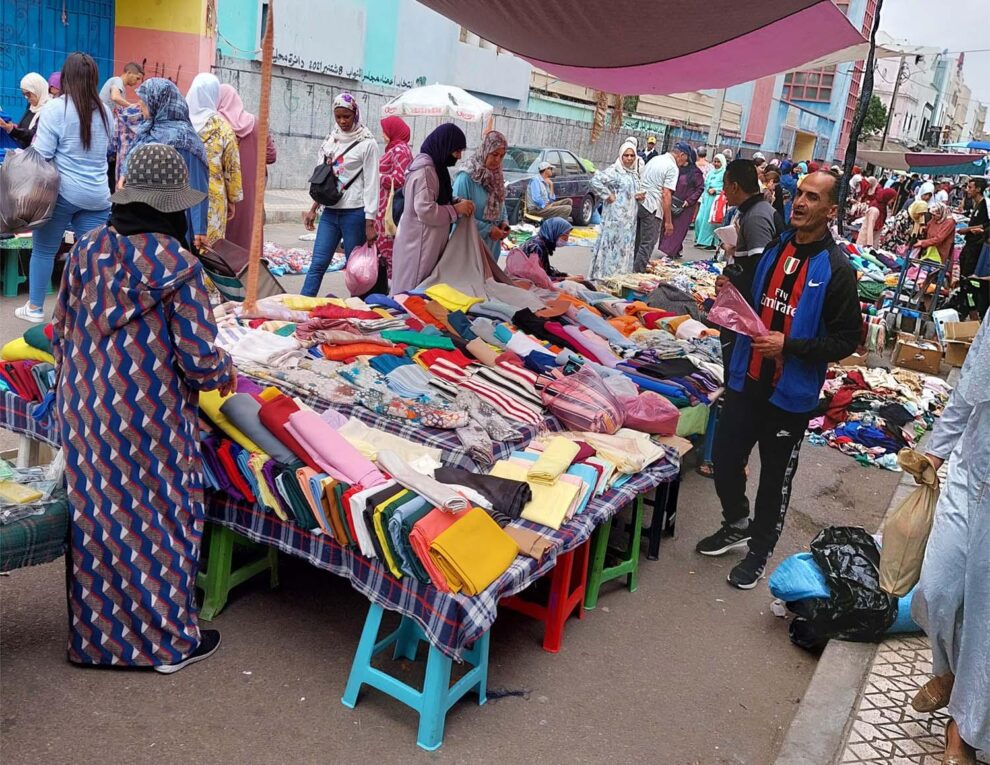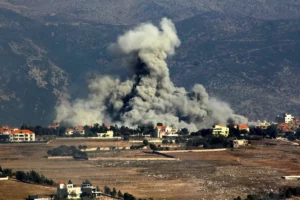Morocco continues to lay the foundations for solid economic modernisation and development, according to various indicators.
Since his accession to the throne in 1999, Morocco’s King Mohammed VI has been clear that the country should take a step forward in terms of its development in various areas, and the economic and industrial spheres have not escaped this state planning.
Morocco’s current economic readiness is demonstrated by data from various institutions showing the good health of Moroccan finances. 2023 also augurs well for national financial performance. Along these lines, the European Bank for Reconstruction and Development (EBRD) presented a report in which it forecasts a growth rate of 3.1% for the Moroccan economy this year, higher than that of neighbouring countries such as Algeria, which has a growth forecast of 2.1%, or Tunisia, with 2%.

The EBRD has also joined the predictions of the World Bank (WB), since both entities estimate that the Gross Domestic Product (GDP), the macroeconomic magnitude that expresses the monetary value of the production of goods and services of final demand, will have a growth rate of 3.1% during 2023, far exceeding the figure for 2022, which stood at 2.1%.
Going deeper into these forecasts, the WB also projects that by 2024 the Moroccan country will grow by 3.4%, if it continues to implement the structural reforms planned to improve competitiveness.
The International Monetary Fund (IMF) also forecasts that Morocco’s economy will grow by 3 , a very positive figure that would even be slightly higher in 2024, according to the international financial institution’s calculations. The EBRD itself also forecasts a growth rate of 3.2% for the Moroccan economy in 2024.

The similar data offered by these prestigious economic entities coincide in the good economic outlook for the North African country, with growth of around 3%, which, although not very excessive, does invite remarkable optimism because it must be borne in mind that the current global circumstances are not the best, with the Russian invasion of Ukraine, which has led to a rise in prices in the energy market and other raw materials, and inflation itself, which is being felt in many parts of the world.
GDP growth is very important for an economy, as it is a reflection of increased economic activity. If economic activity picks up, unemployment tends to fall and, logically, per capita income rises. This can also lead to economic agents becoming more inclined to spend rather than save. Moreover, following an increase in GDP, the state’s tax revenues tend to rise, as the state collects more taxes and can therefore allocate these amounts to spending items. Morocco’s current GDP stood at $142.867 billion in 2021, ranking 59th in the world by GDP volume, and the trend is upward.

Economic and industrial development
The Moroccan government, under the leadership of King Mohammed VI, is clearly committed to national economic and industrial development. Despite the economic slowdown, the Moroccan government is committed to implementing policies aimed at increasing public and private investment in different sectors such as infrastructure, rural areas and education. All of this has been boosted by an important commitment to national industrial development, which was highlighted by the celebration in Casablanca of the Moroccan Industry Day, an important event that highlighted the important industrial and economic evolution that the Moroccan kingdom is undergoing. At the event held in Casablanca in April, it was highlighted that Moroccan industry continues to take off in various sectors such as the automotive, textile and agro-industrial sectors. As an example of this, the success story of the aeronautical industry can be highlighted, which now has 140 companies operating in the sector in Morocco, with great development, given that 20 years ago there were only 4 or 5. These 140 companies in the sector directly and indirectly employ 20,000 people, as Karim Cheikh, president of the Moroccan Aeronautical and Space Industries Group, explained to Atalayar. Cheikh also stressed that Morocco is the leading country in Africa in terms of technological development in the aeronautical sector. .

Morocco has made a firm commitment to innovation and investment in its industry, following the industrial revitalisation plan drawn up by the Moroccan state, which combines collaboration between the private and public sectors, and this is bearing fruit and having a favourable impact on the economy.
There are currently several strategic sectors in Morocco that show the national upward trend, such as the aerospace, automotive, agro-industrial, metallurgical and energy sectors, with the recent discoveries of gas and oil fields in Morocco being managed by companies such as Sound Energy and Chariot, which could provide a major boost to the country’s energy supply and the generation of wealth in the nation.
As Mohammed Reda Lahmini, head of the Innovation Commission of the General Confederation of Moroccan Enterprises (CGEM), told Atalayar, King Mohammed VI set an investment target of 550 billion dirhams between now and 2026 during the opening of the Parliament’s sessions last October, with a view to generating some 500,000 jobs.

The search for investment remains a major challenge for the Moroccan authorities. The government led by Prime Minister Aziz Akhannouch is working in this direction with fiscal measures to promote investment in the national economy and industry, despite the current difficult international context, marked by the war in Ukraine and problems such as inflation. For Mohammed Reda Lahmini himself, “the legal and fiscal framework is one of the key success factors to accompany the investor today, the fiscal aspect is very important”. The Moroccan government’s current taxation framework law aims to make the Moroccan tax system attractive, and the CGEM itself actively contributes to the development of the taxation framework law with the government through the various finance law

Investor confidence in Morocco has also been boosted by the country’s removal from the grey list of the Financial Action Task Force (FATF). The FATF unanimously decided to remove the North African country from the list and this is a strong endorsement that demonstrates Morocco’s good performance in terms of financial governance and its important fight against money laundering. The FATF’s decision thus strengthens the Kingdom’s image and position in negotiations with international financial institutions, as well as the confidence of foreign investors in the national economy.
The government has planned measures aimed at improving the investment climate and attracting foreign investment, such as tax cuts for new investors, increased funding for the development of renewable energy, liberalisation measures in the agricultural sector, reduction of energy subsidies, regulatory reduction for businesses and economic diversification.

Job creation
Morocco’s Minister of Industry, Ryad Mezzour, pointed out that so far in the current government’s term of office, 100,000 jobs have already been created and the country is on track to reach 400,000 jobs in the industrial sector, an objective that will be achieved thanks to vocational training, research and innovation. Chakib Alj, president of the Moroccan employers’ association CGEM, explained that all the elements that make up the private sector are mobilised to ensure that industry becomes the economic future of the country. To this end, he emphasised two main aspects: investment in R&D (Morocco invests 0.8% of GDP compared to other countries in the developed world, which invest 2.8%) and artificial intelligence.
Improved investor confidence is contributing to Morocco’s economic improvement, as are good agricultural market data and moderating inflation. Of note here is the fact that Morocco’s agricultural exports to the European Union reached €1.25 billion in 2021. The agricultural and fisheries sector accounted for 12% of Moroccan GDP in 2021. This sector has benefited from the 2008 “Green Morocco Plan”, which boosted the development of farms and the integration of small farmers into national and international supply chains. In ten years, investments in the agricultural sector reached 104 billion dirhams (almost 10 billion euros). This plan is being continued with the Green Generation Plan for the period 2020-2030, which plans to increase agricultural production, improve Moroccan farmers’ incomes and even reduce water consumption in the agricultural industry.

For its part, Morocco’s Investment Commission approved 21 projects with a budget of $7.6 billion, with the intention that the planned projects will generate around 5,800 direct employment opportunities and create around 15,000 additional indirect jobs. The projects are largely concentrated in the industrial sector, worth $5.3 billion, almost 70% of the total investments. Tourism and healthcare account for 8% of these investments, behind seawater desalination projects, which account for 14% of this budget.

Business creation
Another figure that demonstrates Morocco’s economic vigour is the number of companies created in the Kingdom. During the first three months of 2023, the number of new companies in the North African country exceeded 24,500, according to data from the Moroccan Industrial and Commercial Property Office (OMPIC).
In detail and again according to OMPIC, this figure is divided between legal entities (16,357 companies) and individuals (8,187 companies). Furthermore, the sectoral classification of the companies created is dominated by the commerce sector (37.03%), followed by construction and public works and real estate activities (18.49%), miscellaneous services (17.47%), transport (8.18%), industry (6.95%), hotels and restaurants (6.26%), the information and communications technology (ICT) sector (2.89%), agriculture and fishing (1.70%) and financial activities (1.02%).
These new companies are sure to contribute to the generation of more wealth and jobs and to the increase in the production of goods and services in the North African nation.
Source: Atalayar

















Add Comment